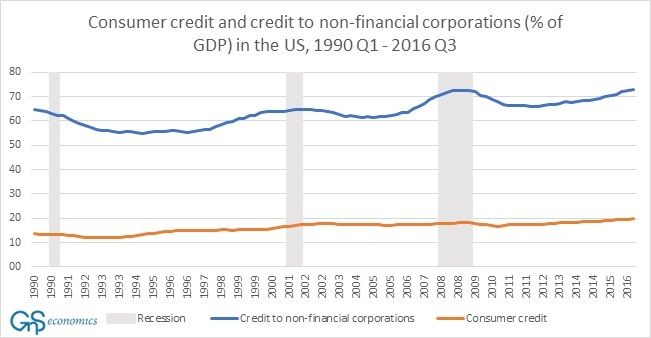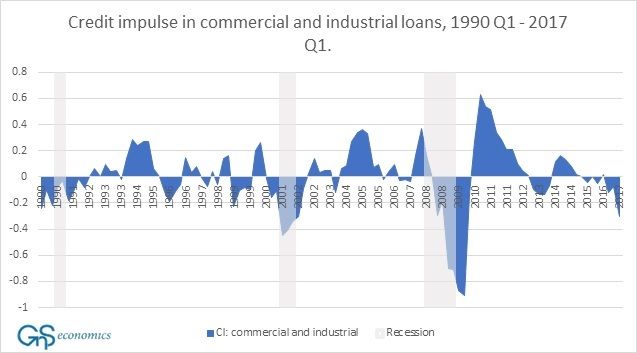Global economy is in a somewhat schizoid phase. There is definitely a hype, especially in the asset markets, about the prospects of the global economy. Markets are expecting a global growth to pick up leading to higher corporate profits.
However, the macroeconomic signals from two leading economies, China and the US, indicate that they are heading to a recession. A recession in either of them has the potential to start a global asset market correction, which can easily metastasize to a global deflationary recession.
The mature expansion of the US
At the very principal level, economic growth consists of two parts. The long-run trend, which is dictated by technological progress enabling continuous production growth, and the business cycle which is driven by the fluctuations in different short-run factors. From these short-run factors, the most prominent one is credit. In an upturn, both consumers and business use credit to expand their consumption and production. This creates a positive pulse in the aggregate demand feeding to more consumption and investment. At the end of the business cycle, the consumers and the corporations have ‘loaded’ themselves with debt and they start to cut back their lending. Credit contracts feeding into a loop of diminishing investment and production.
In the US, the upturn has already lasted for eight years, which makes it the third longest economic expansion since the Second World War. More importantly, the shares of consumer and non-financial corporate total credit from GDP are beyond their former peaks (see Figure 1). These point to a mature business cycle for the US.

Figure 1. Total consumer credit owned and securitized and total credit to non-financial corporations as % of GDP. Source: GnS Economics, Fed St. Louis and BIS
The flow of credit is an important gauge on what’s to come in a mature business cycle. It measures the new borrowing used to increase production. If the flow of credit is declining, then businesses are constraining their investments. Figure 2 presents the flow of credit, or the credit impulse, in commercial and business loans in the US from the beginning of the 1990’s to the first quarter of 2017.

Figure 2. Change in the annual normalized growth (credit impulse) of commercial and industrial loans in the US. Sources: GnS Economics and Fed St. Louis
The figure shows that the credit impulse of commercial and industrial loans has not been this negative outside a recession for the last 27 years. It also shows the difference in the way economic expansions end. During the financial crisis of 2008, the credit impulse turned negative only after the economy was already in recession. Before the short recessions in 1990 and in 2001, the credit impulse of commercial and industrial loans started to decline three to six quarters before the onset of a recession (this holds also for the historical record starting from 1948). The current decline in the credit impulse started in the third quarter last year. Thus, the US economy may be just one to two quarters away from a recession.
China at the end of the road
The economy of China has struggled during the past few years. Its (official) growth rate has fallen to 6.5 percent from over 10 percent before the financial crisis of 2007-2008. At the core of the slowdown of China are her increasingly unproductive investment. Using the official GDP statistics, the unit increase in capital formation per a unit increase in output, or ICOR, was 6.9 while it was 2.9 in 2007. This means that 7 yuans of investments were needed to create 1 yuan worth of output. This decline is visible in the productivity growth. From 2009 to 2015, the annual factor productivity growth was only 0.13 % while from 2000 to 2007 it was 2.9 %. In 2015 and 2016, the factor productivity actually fell by 2.3 and 1.6 percentage points (see Conference Board: alternative TFP measure for China).
As the productivity growth has sacked, credit creation has been used to maintain economic growth. The loan growth currently outpaces output growth by a factor of three. Moody’s Investor Service has estimated that the size of the shadow banking sector of China is around $8.5 trillion dollars. This would bring the total private debt of China close to 300 % of GDP. A terrifying rate for any developing nation.
Political momentum and central bank meddling
There is a clear political momentum towards postponing the upcoming global recession. President Trump has taken some credit on the inflated asset prices since his election. FED president Janet Yellen is desperately trying to get interest rates higher before the next recession starts and authorities in China are trying to postpone the inevitable (recession and rebalancing) at least until the 19th National Congress of the Communist Party held in the fall.
It is also likely that central bankers around the world are acutely aware of the ‘monster’ they have created. An asset market crash would bring their questionable means (zero interest rates and QE) into scrutiny. As it is more than likely that the central bankers try to do their best to postpone this, there are no guarantees that they will not resort to even more desperate measures, including the (direct) monetization of government debt and/or the helicopter drops of money (see also recent actions by the BoJ and the SNB). Still, in the long run, the markets will prevail over central planning. No amount of “funny money” (value not based on market activities) created by the central banks nor the government induced stimulus can dictate the market process permanently. When the tide turns and faith to centrally planned valuation levels evaporates, prices will adjust to the level dictated by the prospects and risks of the real economy. In the current situation, this means a global deflation on a massive scale.
Everything is set for a major global crash and a deflationary recession. Still, the timing the start of the recession is extraordinarily difficult, because the authorities of China and global central bankers seem to have determined to keep everything afloat until the bitter end.
